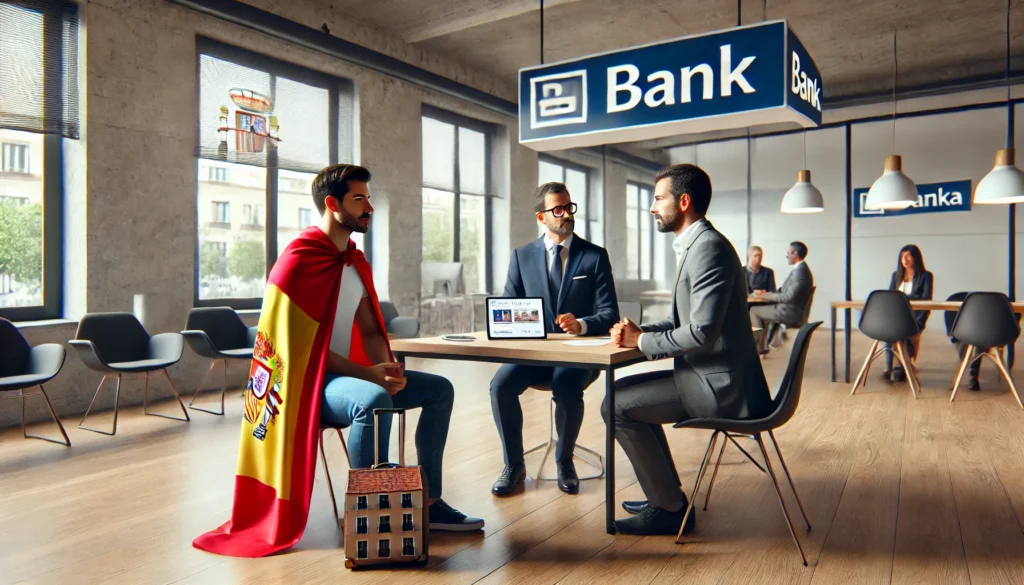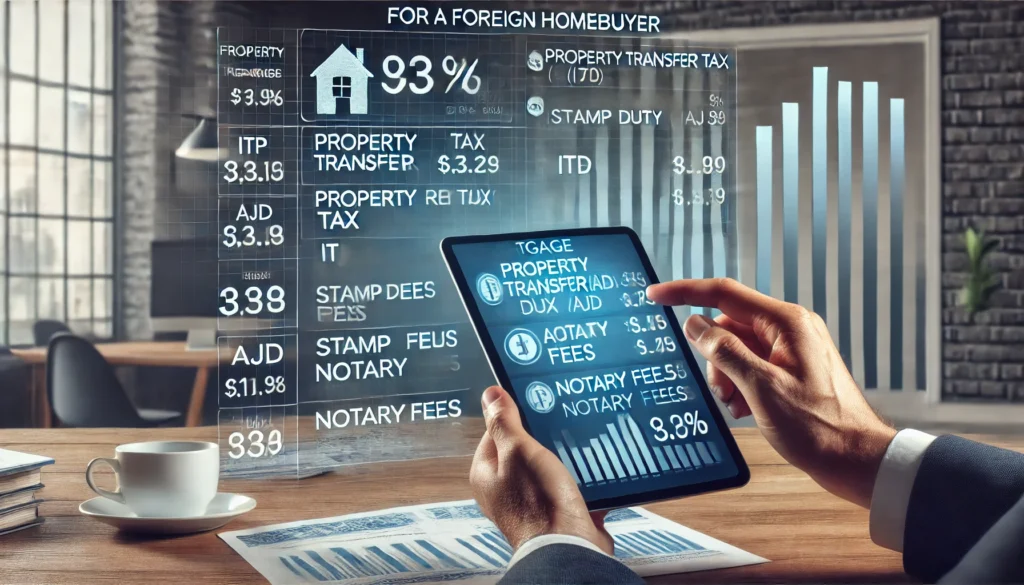1. Introduction
Calpe, a stunning coastal town on Spain’s Costa Blanca, has become a prime destination for international property buyers. With its Mediterranean climate, picturesque beaches, and strong real estate market, Calpe attracts investors, retirees, and second-home buyers from all over the world.
For foreign buyers, purchasing property in Spain can be straightforward, but financing the purchase requires understanding the Spanish mortgage system, bank requirements, and legal obligations. While Spanish banks do offer mortgages to non-residents, they have different lending criteria compared to Spanish residents.
Why is it important to understand financing before buying?
✅ Helps determine how much you can borrow before starting your property search.
✅ Ensures you’re prepared for the down payment and closing costs.
✅ Avoids surprises related to interest rates, taxes, and fees.
✅ Increases your chances of mortgage approval by following the right steps.
Quick Summary of the Mortgage Process for Foreign Buyers
🔹 Check Eligibility – Understand loan conditions for non-residents.
🔹 Gather Documentation – NIE number, income proof, property agreements.
🔹 Compare Lenders – Choose between Spanish banks, international banks, and brokers.
🔹 Apply for Pre-Approval – Determine borrowing limits before searching for properties.
🔹 Secure a Mortgage – Submit application, get valuation, sign agreement.
🔹 Finalize the Purchase – Close the deal at a notary and register the property.
For a step-by-step guide on buying property in Calpe as a foreigner, check out How to Buy Property in Calpe as a Foreigner.

2. Understanding Spanish Mortgage Basics
Spain has a well-developed mortgage market, and many banks offer loans to foreigners. However, there are key differences in financing conditions between residents and non-residents.
How Do Spanish Banks Provide Mortgages to Foreign Buyers?
Spanish banks are willing to lend to foreigners, but they apply stricter conditions than they do for residents. Foreign buyers generally need to provide more extensive documentation, higher down payments, and proof of income stability.
To reduce risk, Spanish banks typically:
✔ Offer lower Loan-to-Value (LTV) ratios to non-residents.
✔ Require higher down payments (often 30-40%).
✔ Charge slightly higher interest rates compared to resident buyers.
✔ Conduct thorough financial background checks before approval.
For detailed information on property investment, see Investing in Property in Calpe – 2025 Guide.
Key Differences: Resident vs. Non-Resident Financing
| Criteria | Spanish Residents | Non-Residents |
| Maximum Loan-to-Value (LTV) | Up to 80% | 60-70% |
| Down Payment Required | 20% | 30-40% |
| Typical Interest Rate | 2.5% – 3.5% | 3% – 5% |
| Mortgage Term | Up to 30 years | Up to 20-25 years |
| Additional Requirements | Standard documentation | Additional proof of income & assets |
What is Loan-to-Value (LTV), and How Does It Affect You?
LTV is the percentage of the property’s price that the bank is willing to finance through a mortgage. The remaining amount must be covered by the buyer’s down payment.
🔹 Residents – Can borrow up to 80% LTV, meaning they only need a 20% down payment.
🔹 Non-Residents – Typically limited to 60-70% LTV, meaning they need a 30-40% down payment.
🔹 100% Mortgages? – These are rare but possible when buying bank-owned properties.
Example of Loan-to-Value Calculation
If you’re buying a €300,000 property in Calpe, here’s how much you would need as a down payment:
- Spanish Resident (80% LTV) → Mortgage: €240,000 | Down Payment: €60,000
- Non-Resident (70% LTV) → Mortgage: €210,000 | Down Payment: €90,000
- Non-Resident (60% LTV) → Mortgage: €180,000 | Down Payment: €120,000
Key Takeaways for Foreign Buyers
✅ Non-residents can typically borrow 60-70% of the property value.
✅ Expect to pay a minimum of 30-40% as a down payment.
✅ Higher deposits mean better mortgage conditions and lower interest rates.
✅ Bank-owned properties may offer better financing options (up to 100% LTV).
For an in-depth guide on choosing the right location for investment, check out Best Neighborhoods to Buy a Home in Calpe – 2025.

3. Key Requirements: Documents Needed for a Mortgage in Spain
Applying for a mortgage as a foreigner in Spain requires gathering essential documents to prove your financial stability and eligibility. Spanish banks conduct thorough background checks on non-residents before approving a loan. Here’s what you need to prepare:
Essential Documents for Non-Residents Applying for a Mortgage
| Document | Purpose |
| NIE Number (Número de Identidad de Extranjero) | Required for all financial and legal transactions in Spain. |
| Valid Passport | Identity verification for non-EU applicants. |
| Proof of Employment or Stable Income | Recent payslips (last 3 months), tax returns, or bank statements. |
| Preliminary Agreement with the Seller | A signed reservation contract or deposit contract (Contrato de Arras). |
| Property Tax Payment Proof | Confirms that the property has no outstanding tax debts. |
| Details of Existing Debts & Assets | Includes mortgages, loans, and real estate holdings (both in Spain and abroad). |
| Bank Statements (Last 6-12 Months) | Shows financial health and ability to afford the mortgage. |
| Credit History Report | A financial background check from your home country. |
| Foreign Tax Declaration Form (if applicable) | Some banks require proof of tax residency outside Spain. |
💡 Tip: Some banks may also request additional documents, such as proof of residence or a reference letter from your bank. If self-employed, you may need to submit company accounts and tax declarations.
🔹 For a step-by-step guide on how to buy property in Calpe as a foreigner, visit:
📌 How to Buy Property in Calpe as a Foreigner
How to Obtain an NIE Number for a Mortgage Application?
A Número de Identidad de Extranjero (NIE) is required for non-residents to apply for a mortgage in Spain. You can obtain an NIE by:
✅ Applying at a Spanish Consulate in your home country – Takes 4-8 weeks.
✅ Visiting the Foreigners Office (Oficina de Extranjería) in Spain – Requires an appointment.
✅ Using a Spanish lawyer or mortgage broker – Some banks may assist in obtaining an NIE for mortgage applicants.
🔹 Need an NIE? Learn more at: Requirements for Foreigners to Buy a House in Calpe
How Important is Credit History for Foreign Buyers?
Spanish banks review your credit history to assess the risk of lending to non-residents. Many banks:
✔ Request credit reports from your home country (Experian, Equifax, etc.).
✔ Evaluate your debt-to-income ratio (DTI) to determine affordability.
✔ Prefer applicants with low outstanding debts and stable income sources.
🔹 For a detailed mortgage guide, visit: Investing in Property in Calpe – 2025 Guide

4. Choosing the Right Lender
Finding the right lender is crucial when financing a property in Spain. Different banks offer varying mortgage terms, interest rates, and conditions for non-residents.
Best Banks in Spain for Foreign Buyers
| Bank | Why Choose Them? |
| Banco Sabadell | Specializes in mortgages for non-residents with competitive rates. |
| BBVA | Offers flexible repayment options and loans in multiple currencies. |
| CaixaBank | Provides expat-friendly mortgages and tailored solutions. |
| Bankinter | Allows up to 70% LTV for foreign buyers with competitive interest rates. |
| Santander | One of Spain’s largest banks, offering long-term mortgage terms. |
🔹 Compare lenders at: Spanish Mortgage Rates – Idealista
How to Compare Lenders and Secure the Best Mortgage Terms
1️⃣ Interest Rates: Compare fixed vs. variable mortgage rates.
2️⃣ Loan-to-Value (LTV): Some banks allow higher financing percentages for certain buyers.
3️⃣ Mortgage Term Length: Shorter terms mean higher monthly payments but lower interest costs.
4️⃣ Repayment Flexibility: Check for early repayment penalties.
5️⃣ Foreign Buyer Support: Some banks offer English-speaking mortgage specialists.
💡 Tip: Always request a preliminary mortgage offer (Oferta Vinculante) to compare lenders before committing.
Why Consider a Mortgage Broker?
A mortgage broker can help simplify the financing process by:
✔ Comparing multiple lenders on your behalf.
✔ Helping negotiate better interest rates.
✔ Handling paperwork and NIE applications.
✔ Providing access to exclusive mortgage deals for foreign buyers.
🔹 Looking for expert mortgage advice? Visit: Spain Mortgage Brokers – Mortgage Direct

5. Getting Pre-Qualified: Why It Matters
If you’re a foreign buyer looking to finance a property purchase in Calpe, getting pre-qualified for a mortgage is an essential step. Pre-qualification allows you to understand how much you can borrow and ensures you are financially prepared before house hunting.
What is Mortgage Pre-Qualification?
Mortgage pre-qualification is an initial assessment by a lender to determine how much financing you may be eligible for. It is not a loan approval, but it provides a clear estimate of:
✔ Loan amount – How much a bank is willing to lend.
✔ Interest rates – Estimated rates based on your financial status.
✔ LTV Ratio – How much down payment you need.
✔ Repayment terms – Monthly payments and loan duration.
💡 Tip: Pre-qualification is non-binding, meaning you are not obligated to accept the lender’s offer.
Why Should Foreign Buyers Get Pre-Qualified?
✅ Know Your Budget – Avoid falling in love with a home that’s out of reach.
✅ Stronger Negotiation Power – Sellers take you more seriously if you have a mortgage pre-approval.
✅ Faster Purchase Process – Banks will process your mortgage quicker once you find a property.
✅ Compare Lenders – Pre-qualify with multiple banks to secure the best rate.
How to Get Pre-Qualified for a Mortgage in Spain?
1️⃣ Gather Financial Documents – Bank statements, tax returns, proof of income.
2️⃣ Choose Your Preferred Lender – Compare banks or work with a mortgage broker.
3️⃣ Submit an Initial Application – Provide financial details to the lender.
4️⃣ Receive an Indicative Offer – The bank will outline loan terms, interest rates, and max LTV.
5️⃣ Compare Multiple Offers – Approach at least 3 lenders to find the best deal.
🔹 For more tips on securing a mortgage, visit:
📌 How to Buy Property in Calpe as a Foreigner

6. Costs and Fees Associated with Getting a Mortgage in Spain
Beyond the property price, buyers must budget an additional 10-12% for taxes, fees, and administrative costs. Understanding these costs upfront prevents financial surprises.
Breakdown of Mortgage Costs & Fees for Foreign Buyers
| Expense | Cost Estimate | Who Pays? |
| Mortgage Setup Fee (Opening Commission) | 1%-2% of loan amount | Buyer |
| Property Transfer Tax (ITP) (Resale Properties) | 8%-10% of purchase price | Buyer |
| VAT (IVA) + Stamp Duty (AJD) (New Properties Only) | 10% IVA + 1.5% AJD | Buyer |
| Notary Fees | €600 – €1,500 | Buyer |
| Land Registry Fees | 1%-2% of purchase price | Buyer |
| Mortgage Registration Fees | 0.5%-1% of mortgage amount | Buyer |
| Banking Fees (Mortgage Setup & Admin) | €500 – €1,000 | Buyer |
📌 Example: If purchasing a €300,000 resale home, expect an additional €30,000 – €36,000 in taxes and fees.
Explanation of Key Fees
💰 Mortgage Setup Fees:
- Spanish banks charge a “Comisión de Apertura” (Opening Commission), ranging from 1%-2% of the loan amount.
- Some banks waive this fee for premium clients or higher down payments.
📜 Property Transfer Tax (ITP) for Resale Properties:
- 8%-10% of purchase price, depending on the region.
- In Calpe (Comunidad Valenciana), the standard rate is 10%.
🏗 VAT (IVA) + Stamp Duty (AJD) for New Developments:
- 10% VAT (IVA) + 1.5% Stamp Duty (AJD) for new builds purchased directly from a developer.
✍ Notary & Land Registry Fees:
- Notary Fees: €600 – €1,500, depending on property value.
- Land Registry Fees: 1%-2% of the property price to officially register the property.
🏦 Banking & Mortgage Fees:
- Some banks charge an additional 0.5%-1% for mortgage registration and administrative paperwork.
- It’s best to ask your lender upfront about these fees.
How to Reduce Mortgage Costs as a Foreigner?
✅ Negotiate mortgage fees – Some banks may reduce the opening commission.
✅ Check if your mortgage covers costs – Some Spanish banks bundle registration and notary fees into the loan.
✅ Work with a mortgage broker – They may secure better financing terms with reduced fees.
🔹 For a full breakdown of mortgage fees, visit:
📌 Investing in Property in Calpe – 2025 Guide

7. The Role of Property Valuation
One of the most important steps in securing a mortgage in Spain is property valuation. Spanish banks require an independent valuation (tasación) before approving a mortgage to ensure the property’s market value aligns with the loan amount.
Why Do Banks Require a Property Valuation?
🏡 Mortgage Risk Assessment – Ensures the property is worth the amount being borrowed.
🏦 Loan-to-Value (LTV) Calculation – The mortgage amount is based on the valuation, not the purchase price.
⚖️ Legal Compliance – Spanish law mandates all mortgage-backed purchases must have an official valuation.
💡 Key Fact: Banks will only lend based on the lower amount between the valuation price and the agreed purchase price.
Who Pays for the Property Valuation?
📌 The buyer (borrower) is responsible for the valuation cost.
📌 The price typically ranges between €300 – €800, depending on property size and location.
📌 The bank usually arranges the valuation, but buyers can hire an independent appraiser registered with the Bank of Spain.
How Does the Valuation Affect the Mortgage?
✔ If the valuation matches or exceeds the purchase price, the mortgage application proceeds smoothly.
❌ If the valuation is lower than expected, the bank may reduce the loan amount, requiring the buyer to increase their down payment.
📌 If the valuation is too low, renegotiating the price with the seller may be an option.
What Happens After the Valuation?
1️⃣ The appraiser submits a property valuation report to the bank.
2️⃣ The bank reviews the valuation and finalizes the mortgage offer based on the LTV.
3️⃣ If everything is satisfactory, the bank proceeds with final loan approval.
🔹 For a complete mortgage process breakdown, visit:
📌 How to Buy Property in Calpe as a Foreigner

8. Step-by-Step Process to Apply for a Mortgage in Calpe
Applying for a mortgage as a foreigner in Spain involves multiple steps, from obtaining legal documents to finalizing the mortgage contract. Below is a detailed step-by-step guide to successfully secure financing in Calpe.
1️⃣ Obtain an NIE Number
📌 The NIE (Número de Identidad de Extranjero) is required for all legal and financial transactions in Spain, including buying property and applying for a mortgage.
📍 Where to apply?
- Spanish Consulate in your home country.
- Foreigners’ Office (Oficina de Extranjería) in Spain.
- Through a Spanish lawyer or real estate agent.
📌 Processing Time: 1-6 weeks, depending on location.
2️⃣ Find a Mortgage Broker or Direct Lender
Buyers can apply for a mortgage either:
✔ Directly with Spanish banks (e.g., Banco Santander, BBVA, CaixaBank).
✔ Through a mortgage broker who helps compare loan options from multiple lenders.
💡 Why Use a Mortgage Broker?
✅ They help find better interest rates and negotiate terms.
✅ They simplify paperwork and application processing.
✅ Some brokers specialize in foreign buyer mortgages.
🔹 Recommended mortgage brokers in Spain:
📌 Mortgage Direct Spain – www.mortgagedirectsl.com
📌 Hipotecas.com – www.hipotecas.com
3️⃣ Get Pre-Qualified for a Mortgage
📌 Pre-qualification helps you understand how much you can borrow and your estimated interest rate.
🔹 What does pre-qualification involve?
✔ Submitting basic financial information (income, assets, debts).
✔ Receiving a non-binding estimate of loan terms.
✔ Helps you focus on properties within your budget.
4️⃣ Gather Required Documents
Before submitting a mortgage application, banks require:
✔ NIE Number (Spanish tax identification number).
✔ Proof of Income – Recent payslips, tax returns, employment contract.
✔ Bank Statements – Last 6-12 months to assess financial stability.
✔ Debt & Asset Overview – Details of existing loans, investments, and property ownership.
✔ Preliminary Sales Agreement (Contrato de Arras) – Proof of property purchase intent.
✔ Foreign Tax Declaration Form (if applicable).
📌 Tip: Some lenders require documents translated into Spanish and notarized.
5️⃣ Submit Mortgage Application
📌 Once documents are ready, submit the mortgage application to your chosen bank.
💡 What happens after submission?
✔ The bank reviews income, credit history, and debt ratio.
✔ A property valuation is ordered (see Section 7).
✔ The bank confirms the loan amount, interest rate, and repayment terms.
⏳ Approval Timeline: 4-8 weeks (depending on the bank).
6️⃣ Negotiate Mortgage Terms
📌 Once approved, review and negotiate:
✔ Interest rate (fixed, variable, or mixed).
✔ Loan-to-Value (LTV) ratio and down payment amount.
✔ Additional fees (setup costs, early repayment penalties, etc.).
💡 Tip: Some lenders waive mortgage fees for premium clients or larger down payments.
7️⃣ Sign the Mortgage Agreement at the Notary
📌 Final Step: Signing the mortgage contract and Escritura de Compraventa (Deed of Sale) in front of a notary.
🏦 At the notary’s office:
✔ The bank transfers funds to the seller.
✔ The buyer receives official property ownership rights.
✔ The mortgage is registered in the Land Registry.
📌 Final Processing Time: 1-3 months for all legal registration to be completed.

9. Alternative Financing Options for Foreign Buyers
While traditional Spanish bank mortgages are the most common way to finance a property in Calpe, foreign buyers may also explore alternative financing options. These can offer greater flexibility, especially for those who may not meet the strict lending requirements of Spanish banks.
Private Lenders & International Banks
🔹 Why Choose a Private Lender?
✔ Less stringent lending criteria – Ideal for buyers with unconventional income sources.
✔ Faster approval process – Funds can be available in days or weeks rather than months.
✔ More flexibility – Custom repayment schedules and higher Loan-to-Value (LTV) ratios.
🚨 Downsides:
❌ Higher interest rates (typically 6-12%, compared to 2-5% for traditional banks).
❌ Larger fees and prepayment penalties may apply.
📌 Top International Lenders Offering Spanish Property Loans:
🏦 HSBC Expat – www.expat.hsbc.com
🏦 Barclays International Banking – www.barclays.co.uk/international
🏦 BNP Paribas International – www.bnpparibas.com
Seller Financing (Rent-to-Own Agreements)
💡 Some property sellers in Spain offer direct financing, where the buyer makes monthly payments to the seller instead of a bank.
📌 How It Works:
✔ The buyer pays a deposit (often 10-20%) and makes fixed monthly payments.
✔ The property remains in the seller’s name until the full amount is paid.
✔ Once payments are complete, ownership is legally transferred to the buyer.
🔹 Pros:
✔ No need for a bank mortgage – Avoid strict lending requirements.
✔ Flexible repayment terms – Buyers can negotiate lower interest rates.
✔ Faster approval – Avoid long waiting times from banks.
🚨 Cons:
❌ Not all sellers offer this option.
❌ Buyer does not legally own the property until payments are complete.
❌ If payments are missed, the buyer may lose the deposit.
📌 Tip: Always consult a real estate lawyer before entering a seller financing agreement to ensure legal protection.
Cash Purchases vs. Financed Purchases: Which is the Better Option?
💰 Buying in Cash
✔ Faster and avoids the complex mortgage approval process.
✔ No interest payments or long-term debt.
✔ Greater negotiating power with sellers.
🚨 However, tying up all liquidity in real estate may not be ideal.
🏦 Buying with Financing
✔ Allows buyers to invest elsewhere while owning property.
✔ Lower upfront capital required.
✔ Mortgage interest payments may be tax-deductible in some cases.
🚨 However, banks require high down payments and extensive paperwork.
📌 Tip: Buyers with sufficient capital often combine both options – placing a large down payment to reduce loan costs while keeping some liquidity available.
🔎 Need help finding the best financing option? Read:
📌 Investing in Property in Calpe – 2025 Guide

10. Tips for Getting Approved for a Mortgage as a Foreigner
📌 Getting a mortgage in Spain as a foreigner can be a complex process, but proper preparation can significantly increase approval chances.
✅ Start the Mortgage Application Process Early
⏳ Mortgage approval in Spain takes 4-8 weeks, so it’s best to start before making an offer on a property.
💡 Steps to Speed Up Approval:
✔ Get your NIE number in advance.
✔ Work with a mortgage broker to compare offers.
✔ Obtain pre-qualification to understand borrowing limits.
✅ Work with a Real Estate Lawyer & Mortgage Specialist
🔹 Why Hire a Lawyer?
✔ Ensures all documents are in order before applying.
✔ Helps negotiate better mortgage terms.
✔ Verifies that the property is legally compliant.
🔹 Why Work with a Mortgage Broker?
✔ Brokers compare multiple banks to secure the best deal.
✔ They understand foreign buyer lending criteria.
✔ Some lenders only work through brokers, offering exclusive rates.
📌 Recommended Brokers:
📌 Mortgage Direct Spain – www.mortgagedirectsl.com
📌 Hipotecas.com – www.hipotecas.com
✅ Ensure a Strong Credit History & Provide Proof of Income
📌 Spanish banks require buyers to show stable finances and a good credit history.
✔ Proof of Income:
- Salaried Employees: Last 6 months’ payslips & tax returns.
- Self-Employed Buyers: 2 years of tax returns + profit/loss statements.
- Retirees/Investors: Proof of rental income, investments, or pension statements.
✔ Low Debt-to-Income Ratio:
- Most banks require a DTI (Debt-to-Income) ratio below 35-40%.
- This means monthly mortgage payments should not exceed 35-40% of total income.
🚨 If credit history is weak, consider co-signing with a financially stable relative to increase approval chances.
✅ Prepare for a Minimum Down Payment of 30-40%
💰 Foreign buyers need a higher deposit than Spanish residents.
📌 Typical Down Payment Requirements:
🏡 Residents: 20%
🌍 Non-Residents: 30-40%
🏦 100% mortgages are rare but available for bank-owned properties.
✔ Tip: If possible, making a higher down payment (40-50%) can reduce interest rates and increase approval chances.
✅ Compare Interest Rates & Negotiate Better Terms
📌 Mortgage rates vary between banks, so compare offers before signing.
✔ Fixed-Rate Mortgage: Best for long-term stability (2.4-3%).
✔ Variable-Rate Mortgage: Linked to Euribor; may start lower but can increase.
✔ Interest-Only Mortgage: Lower payments for short-term investors.
💡 Negotiation Tips:
✔ Offer a higher down payment to secure better interest rates.
✔ Request to waive mortgage setup fees if borrowing a large amount.
✔ Ask about early repayment penalties before signing.
🔹 For full mortgage comparisons, visit:
📌 Best Banks in Spain for Foreign Mortgages

11. Common Mistakes Foreign Buyers Make When Applying for a Mortgage
Buying a house in Calpe as a foreigner can be a seamless process if done correctly, but many buyers make costly mistakes due to a lack of preparation. Here are the most common pitfalls to avoid when securing a mortgage in Spain.
🚨 Not Obtaining an NIE Number in Advance
📌 The Número de Identificación de Extranjero (NIE) is required for all legal and financial transactions in Spain, including:
✔ Applying for a mortgage.
✔ Signing the purchase contract.
✔ Paying property-related taxes.
🔹 Mistake: Many foreign buyers wait until the last minute to obtain their NIE, causing unnecessary delays.
✅ Solution: Apply for your NIE number at least 1-2 months before starting the mortgage process.
💰 Underestimating Hidden Costs (Taxes, Legal Fees & Bank Charges)
📌 Many buyers focus only on the property price without considering the extra costs involved.
💸 Key Additional Costs:
✔ Mortgage setup fees: 1%-2% of loan amount.
✔ Property Transfer Tax (ITP): 8%-10% (for resale properties).
✔ Stamp Duty (AJD): 1.5% (for new properties).
✔ Notary and land registry fees: 1%-2% of property price.
✔ Banking fees and mortgage registration costs.
🔹 Mistake: Buyers budget only for the down payment, leading to financial stress when the extra 10-12% costs appear.
✅ Solution: Ensure your total budget includes all taxes, fees, and additional costs before applying for a mortgage.
❌ Not Consulting with a Spanish Mortgage Expert
📌 Spanish mortgage requirements differ from those in other countries, and foreign buyers often misunderstand the process.
🔹 Mistake: Applying for a mortgage without understanding Spanish lending criteria can lead to rejections or unfavorable terms.
✅ Solution: Work with a mortgage broker or Spanish real estate lawyer to secure the best financing options.
📌 Need expert advice? Check out:
🔎 How to Buy Property in Calpe as a Foreigner
🏦 Choosing the Wrong Mortgage Type
📌 Spanish banks offer different mortgage options, and choosing the wrong one can lead to financial difficulties.
💡 Types of Mortgages in Spain:
✔ Fixed-Rate Mortgage – Predictable monthly payments but higher initial rates.
✔ Variable-Rate Mortgage – Lower initial interest but fluctuates with the Euribor rate.
✔ Interest-Only Mortgage – Short-term option for investors, but not ideal for long-term buyers.
🔹 Mistake: Some buyers choose variable-rate mortgages without realizing that interest rates may increase in the future.
✅ Solution: Compare multiple lenders and mortgage types before making a final decision.
📌 Need help? Read: Best Mortgage Options for Foreign Buyers
📈 Assuming Interest Rates Will Remain Stable
📌 The Euribor rate determines variable mortgage interest rates in Spain, and it can fluctuate significantly.
🔹 Mistake: Buyers assume their monthly payments will remain the same over time.
✅ Solution: If choosing a variable-rate mortgage, calculate your maximum possible payment increase to ensure affordability.
📌 Tip: Consider a fixed-rate mortgage if you prefer stability and predictable costs.

12. Conclusion & Next Steps
Buying a home in Calpe as a foreigner is an exciting investment opportunity, but securing financing requires preparation. By understanding Spanish mortgage requirements, comparing lenders, and budgeting for all additional costs, foreign buyers can ensure a smooth purchase process.
Key Takeaways:
✅ Start early: Mortgage approvals take 1-1.5 months in Spain.
✅ Get your NIE number: Required for all property transactions.
✅ Compare lenders: Work with a mortgage broker to get the best terms.
✅ Budget for extra costs: Expect to pay 10-12% in additional taxes and fees.
✅ Understand mortgage types: Choose between fixed or variable rates carefully.
📌 What’s Next?
🚀 Start your mortgage journey today!
📌 Step-by-Step Guide to Buying a House in Calpe
📌 Investment Opportunities in Calpe – 2025
Frequently Asked Questions (FAQs)
1️⃣ Can foreigners get a mortgage in Spain?
✅ Yes! Spanish banks offer mortgages to non-residents, but they can typically borrow only 60-70% of the property’s value.
2️⃣ How long does it take to get a mortgage in Spain?
🕒 The mortgage process usually takes 1-1.5 months, including:
✔ Document submission.
✔ Property valuation.
✔ Final lender approval.
📌 Tip: Start the process before house hunting to avoid delays.
3️⃣ What is the minimum deposit required for a mortgage in Spain?
💰 Non-residents typically need a 30-40% down payment.
🏡 Residents can access higher financing up to 80% LTV.
📌 Example: If buying a €300,000 property, a non-resident would need at least €90,000-€120,000 upfront.
4️⃣ What additional costs should I expect when getting a mortgage?
📌 Buyers should budget an extra 10-12% of the property price for:
✔ Mortgage setup fees: 1%-2% of loan amount.
✔ Property Transfer Tax (ITP): 8%-10% (for resale homes).
✔ Notary & land registry fees: 1%-2% of property value.
✔ Stamp Duty (AJD): 1.5% (for new properties).
📌 Tip: Use a mortgage calculator to estimate total costs.
5️⃣ Should I work with a mortgage broker in Spain?
🤝 Yes! Mortgage brokers help compare lenders, negotiate better terms, and simplify the process for foreign buyers.
📌 Recommended Brokers:
🏦 Mortgage Direct Spain – www.mortgagedirectsl.com
🏦 Hipotecas.com – www.hipotecas.com
📌 Read more: Choosing the Best Mortgage Lender in Spain

Pingback:Jobs in Calpe Spain: Ultimate Guide to Employment Opportunities - Invessia